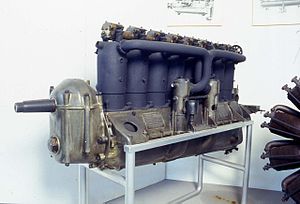
The Fokker D.VII was a German World War I fighter aircraft designed by Reinhold Platz of the Fokker-Flugzeugwerke. Germany produced around 3,300 D.VII aircraft in the second half of 1918. In service with the Luftstreitkräfte, the D.VII quickly proved itself to be a formidable aircraft. The Armistice ending the war specifically required, as the fourth clause of the "Clauses Relating to the Western Front", that Germany was required to surrender all D.VIIs to the Allies. Surviving aircraft saw much service with many countries in the years after World War I.
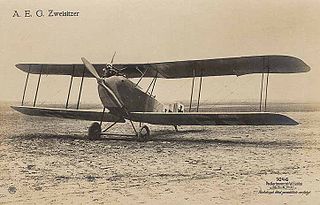
The AEG C.IV was a two-seat biplane reconnaissance aircraft designed and produced by the German aircraft manufacturer Allgemeine Elektrizitäts-Gesellschaft.
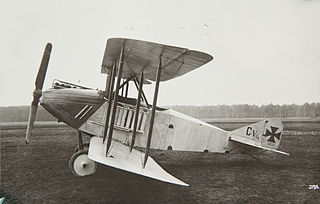
The AEG C.V was a prototype two-seat biplane reconnaissance aircraft of World War I. Designed to use a more powerful engine than previous AEG C-class reconnaissance aircraft, results were disappointing enough that further development was cancelled.

The AEG C.VIII was a prototype two-seat reconnaissance aircraft of World War I. Two examples were built, based on the successful C.IV design, one of biplane configuration, the other a triplane. Neither version offered enough of an improvement on the C.IV to make mass production worthwhile.

The AEG G.III was a German biplane bomber aircraft of World War I developed from the G.II. Like its predecessor, it was only built in small numbers and saw limited operational use, mainly far from the main fronts of the war.

The AEG G.IV was a biplane bomber aircraft designed and produced by the German aircraft manufacturer Allgemeine Elektrizitäts-Gesellschaft. It saw action during the First World War with the Luftstreitkräfte.

The Liberty L-12 is an American water-cooled 45° V-12 aircraft engine displacing 1,649 cubic inches (27 L) and making 400 hp (300 kW) designed for a high power-to-weight ratio and ease of mass production. It saw wide use in aero applications, and, once marinized, in marine use both in racing and runabout boats.

The Fokker D.I was a development of the D.II fighter. The D.I was also flown in Austro-Hungarian service as a fighter trainer aircraft under the designation B.III. Confusing the matter further, both the D.II and D.I arrived at the Front in German service at similar times, in July–August 1916. The main designer was Martin Kreutzer.

The Mercedes D.III, or F1466 as it was known internally, was a six-cylinder SOHC valvetrain liquid-cooled inline aircraft engine built by Daimler and used on a wide variety of German aircraft during World War I. The initial versions were introduced in 1914 at 120 kW (160 hp), but a series of changes improved this to 130 kW (170 hp) in 1917, and 130 kW (180 hp) by mid-1918. These later models were used on almost all late-war German fighters, and its only real competition, the BMW III, was available only in very limited numbers. Compared to the Allied engines it faced, the D.III was generally outdated.
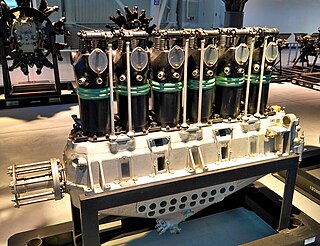
The Benz Bz.IV was a German six-cylinder, water-cooled, inline engine developed for aircraft use. Deliveries began in 1916, and some 6,400 were produced.
The Mercedes D.I was a six-cylinder, water-cooled, SOHC valvetrain inline engine developed in Germany for use in aircraft in 1913. Developing 75 kW (100 hp), it powered many German military aircraft during the very early part of World War I.
The Benz Bz.III was a six-cylinder, water-cooled, inline engine developed in Germany for use in aircraft in 1914. Developing 112 kW (150 hp) at 1,400 rpm from 14.3 L, it powered many German military aircraft during World War I. It was replaced in production by the unrelated Benz Bz.IIIa. and eventually the V-8 Benz Bz.IIIb. The Benz Bz.III was built under licence in Sweden by AB Thulinverken, known as the Thulin E.

The Mercedes D.IVa was a German six-cylinder, water-cooled, inline engine developed in 1917 for use in aircraft and built by Daimler Motoren Gesellschaft (DMG).

The Maybach Mb IVa was a water-cooled aircraft and airship straight-six engine developed in Germany during World War I by Maybach-Motorenbau GmbH, a subsidiary of Zeppelin. It was one of the world's first series-produced engines designed specifically for high-altitude use. It was quite different engine design than the previous Maybach Mb.IV, not just a simple modification.
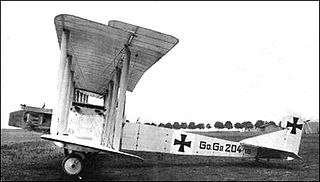
The Gotha G.II series was a heavy bomber used by the Luftstreitkräfte during World War I.
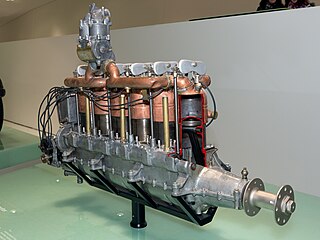
The Austro-Daimler 6 was a series of Austrian six-cylinder water-cooled inline aero engines first produced in 1910 by the Austro-Daimler company.

BMW IIIa was an inline six-cylinder SOHC valvetrain, water-cooled aircraft engine, the first-ever engine produced by Bayerische Flugzeugwerke AG, who, at the time, were exclusively an aircraft engine manufacturer. Its success laid the foundation for future BMW engine designs. It is best known as the powerplant of the Fokker D.VIIF, which outperformed any allied aircraft.
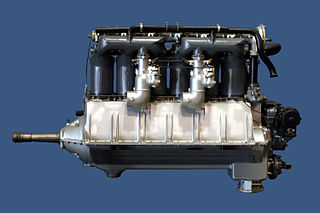
The Liberty L-6 was a six-cylinder water-cooled inline aircraft engine developed in the United States during World War I.

The Conrad C.III was a six-cylinder, water-cooled inline aircraft engine designed by Robert Conrad. It was used on some German training aircraft during World War I. The engine was mainly produced under license by the German Nationale Automobil Gesellschaft.
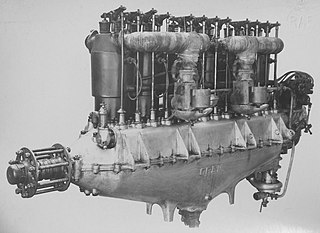
The Argus As III was a six-cylinder, in-line, water-cooled, aircraft engine produced in Germany by Argus Motoren during World War I. The Argus As III produced 180 hp (130 kW) at 1,400 rpm.
